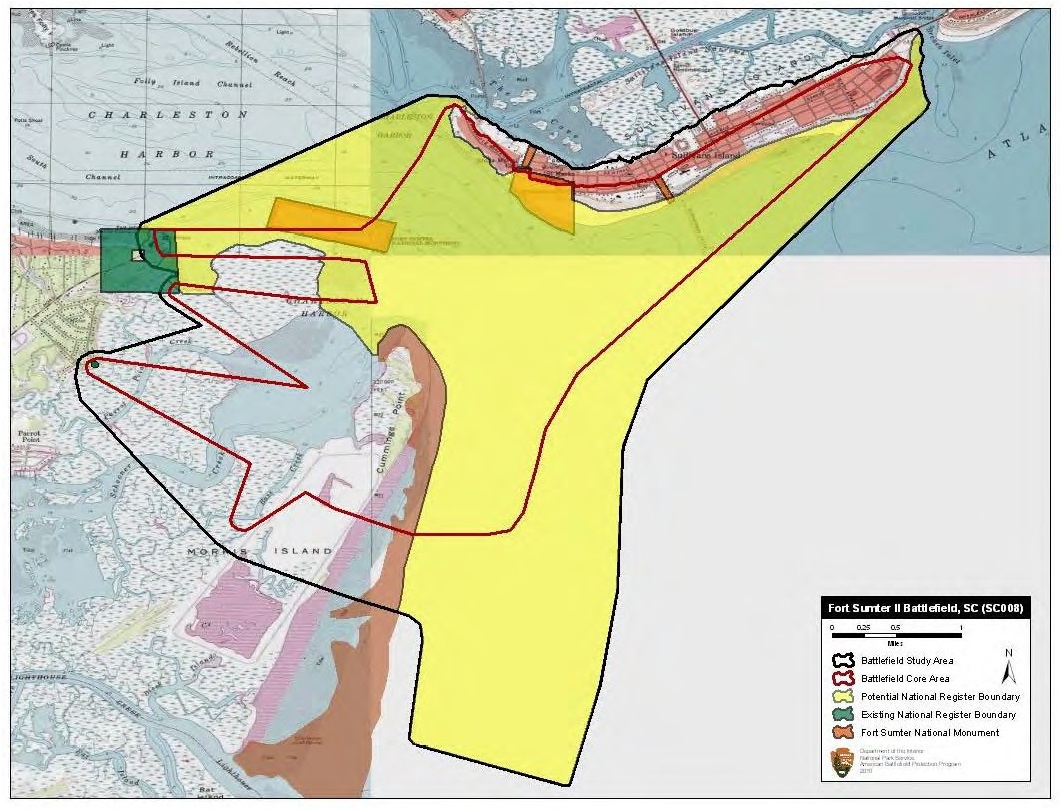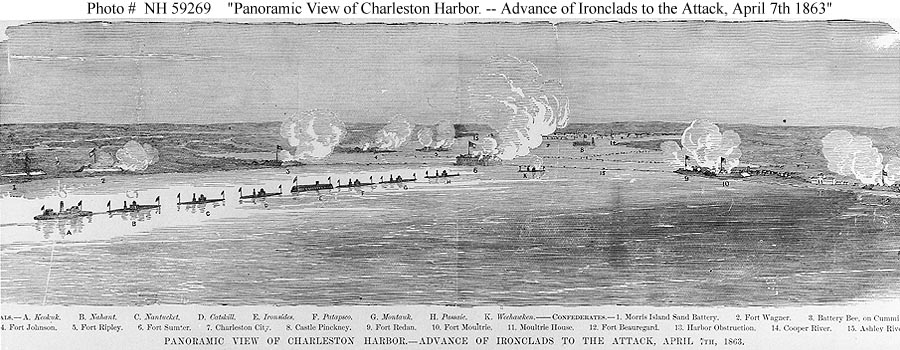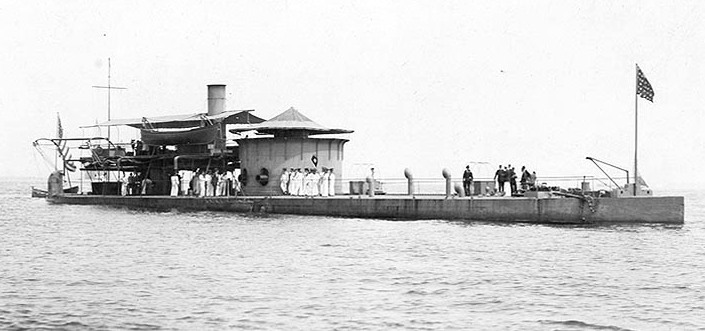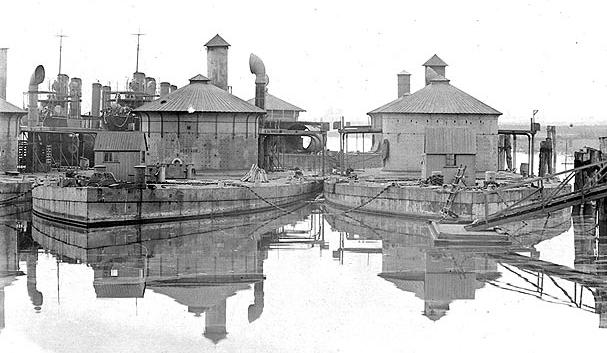|
Second Battle Of Fort Sumter
The Second Battle of Fort Sumter was fought on September 8, 1863, in Charleston Harbor. Confederate General P. G. T. Beauregard, who had commanded the defenses of Charleston and captured Fort Sumter in the first battle of the war, was in overall command of the defenders. In the battle, Union forces under Major General Quincy Gillmore attempted to retake the fort at the mouth of the harbor. Union gunners pummeled the fort from their batteries on Morris Island. After a severe bombing of the fort, Beauregard, suspecting an attack, replaced the artillerymen and all but one of the fort's guns with 320 infantrymen, who repulsed the naval landing party. Gillmore had reduced Fort Sumter to a pile of rubble, but the Confederate flag still waved over the ruins. Background Union efforts to retake Charleston Harbor began on April 7, 1863, when Rear Admiral Samuel Francis Du Pont, commander of the South Atlantic Blockading Squadron, led the ironclad frigate ''New Ironsides'', the tower ... [...More Info...] [...Related Items...] OR: [Wikipedia] [Google] [Baidu] |
American Civil War
The American Civil War (April 12, 1861 – May 26, 1865; also known by other names) was a civil war in the United States. It was fought between the Union ("the North") and the Confederacy ("the South"), the latter formed by states that had seceded. The central cause of the war was the dispute over whether slavery would be permitted to expand into the western territories, leading to more slave states, or be prevented from doing so, which was widely believed would place slavery on a course of ultimate extinction. Decades of political controversy over slavery were brought to a head by the victory in the 1860 U.S. presidential election of Abraham Lincoln, who opposed slavery's expansion into the west. An initial seven southern slave states responded to Lincoln's victory by seceding from the United States and, in 1861, forming the Confederacy. The Confederacy seized U.S. forts and other federal assets within their borders. Led by Confederate President Jefferson Davis, ... [...More Info...] [...Related Items...] OR: [Wikipedia] [Google] [Baidu] |
Ironclad Warship
An ironclad is a steam-propelled warship protected by iron or steel armor plates, constructed from 1859 to the early 1890s. The ironclad was developed as a result of the vulnerability of wooden warships to explosive or incendiary shells. The first ironclad battleship, , was launched by the French Navy in November 1859 - narrowly pre-empting the British Royal Navy. They were first used in warfare in 1862 during the American Civil War, when ironclads operated against wooden ships and, in a historic confrontation, against each other at the Battle of Hampton Roads in Virginia. Their performance demonstrated that the ironclad had replaced the unarmored ship of the line as the most powerful warship afloat. Ironclad gunboats became very successful in the American Civil War. Ironclads were designed for several uses, including as high seas battleships, long-range cruisers, and coastal defense ships. Rapid development of warship design in the late 19th century transformed the ir ... [...More Info...] [...Related Items...] OR: [Wikipedia] [Google] [Baidu] |
Traverse (gunnery)
Traverse may refer to: * Traverse (climbing), skiing, and in the engineering of roads into slopes * Traverse (surveying), a method of establishing basic points in the field * Movement of a machine slide on a machine tool * Traverse stage, a style of theatre seating or performance Other meanings: * TRAVERSE (software), accounting and business software * Traverse (gunnery), the horizontal field of fire of an artillery piece * Traverse (trench warfare), a development in trench design * Traverse (fortification), a mass of earth behind a military parapet * ''Traverse'' (magazine), a Northern Michigan regional monthly * Chevrolet Traverse, a 2009 sport-utility vehicle * Traverse County, Minnesota, a county in Minnesota * Traverse City, Michigan * Traverse, Michigan, an unincorporated community * Traverse Theatre, writing theatre in Scotland * Traverse Town, a fictional city in some Kingdom Hearts series video games * Traverse (common law), a pleading In law as practiced in countr ... [...More Info...] [...Related Items...] OR: [Wikipedia] [Google] [Baidu] |
Dahlgren Gun
Dahlgren guns were muzzle-loading naval artillery designed by Rear Admiral John A. Dahlgren USN (November 13, 1809 – July 12, 1870), mostly used in the period of the American Civil War. Dahlgren's design philosophy evolved from an accidental explosion in 1849 of a gun being tested for accuracy, killing a gunner. He believed a safer, more powerful naval cannon could be designed using more scientific design criteria. Dahlgren guns were designed with a smooth curved shape, equalizing strain and concentrating more weight of metal in the gun breech where the greatest pressure of expanding propellant gases needed to be met to keep the gun from bursting. Because of their rounded contours, Dahlgren guns were nicknamed "soda bottles", a shape which became their most identifiable characteristic. Dahlgren boat howitzers During the Mexican–American War the U.S. found itself lacking in light guns that could be fired from ships’ boats and landed to be used as light artillery in suppor ... [...More Info...] [...Related Items...] OR: [Wikipedia] [Google] [Baidu] |
First Battle Of Charleston Harbor
The First Battle of Charleston Harbor was an engagement near Charleston, South Carolina that took place April 7, 1863, during the American Civil War. The striking force was a fleet of nine ironclad warships of the Union Navy, including seven monitors that were improved versions of the original . A Union Army contingent associated with the attack took no active part in the battle. The ships, under command of Rear Admiral Samuel Francis Du Pont, attacked the Confederate defenses near the entrance to Charleston Harbor. Navy Department officials in Washington hoped for a stunning success that would validate a new form of warfare, with armored warships mounting heavy guns reducing traditional forts. Du Pont had been given seven of the Passaic class monitors, the powerful , and the experimental ironclad . Other naval operations were sidetracked as their resources were diverted to the attack on Charleston. After a long period of preparation, conditions of tide and visibility allowed ... [...More Info...] [...Related Items...] OR: [Wikipedia] [Google] [Baidu] |
USS Nahant (1862)
The first USS ''Nahant'' was a ironclad monitor of the United States Navy that saw service in the American Civil War and the Spanish–American War. ''Nahant'' was launched on October 7, 1862, by Harrison Loring, South Boston, Massachusetts, and commissioned on December 29, 1862, Commander John Downes in command. Service history Fort McAllister The new single- turreted monitor joined the South Atlantic Blockading Squadron at Port Royal Harbor, South Carolina on February 20, 1863, and saw her first action in the Union bombardment of Fort McAllister on March 3. Charleston A little over a month later, she participated in Rear Admiral Samuel Francis du Pont's valiant but ill-fated attack on Charleston Harbor. The ironclads crossed Stono Bar and entered Charleston Harbor on 6 April, but a heavy fog stopped their advance lest they run aground attempting to negotiate the tricky channels leading to the vital Confederate port. Though dawn broke clear the next morning, an ebb tide k ... [...More Info...] [...Related Items...] OR: [Wikipedia] [Google] [Baidu] |
USS Catskill (1862)
USS ''Catskill'' was a monitor built for the United States Navy during the American Civil War. She continued to serve the Navy after the war's end until decommissioned in 1898 after the end of the Spanish–American War. Service history Civil War USS ''Catskill''—a single-turreted monitor—was launched on December 16, 1862 by Continental Iron Works, Greenpoint, New York; outfitted at New York Navy Yard; commissioned on February 24, 1863, Commander George Washington Rodgers in command; and reported to the South Atlantic Blockading Squadron. ''Catskill'' reported for duty at Port Royal, South Carolina on March 5, 1863, and for the remainder of the war operated off Charleston, South Carolina. ''Catskill'' was damaged by Confederate gunfire during the 7 April attack on Fort Sumter that demonstrated both the strengths of well-defended fortifications and the limitations of monitor-type ironclads. That began the lengthy series of operations against the strongly fortified and ... [...More Info...] [...Related Items...] OR: [Wikipedia] [Google] [Baidu] |
USS Nantucket (1862)
The first USS ''Nantucket'' was a coastal monitor in the United States Navy. ''Nantucket'' was launched 6 December 1862 by Atlantic Iron Works, Boston, Massachusetts; and commissioned 26 February 1863, Commander Donald McNeil Fairfax in command. Assigned to the South Atlantic Blockading Squadron, ''Nantucket'' participated in the attack on Confederate forts in Charleston Harbor 7 April 1863. Struck 51 times during the valiant but unsuccessful assault on the vital Southern port, the single-turreted monitor was repaired at Port Royal but returned to Charleston to support Army operations on Morris Island, engaging Fort Wagner 16, 17, 18, and 24 July. She captured British steamer ''Jupiter'' at sea 15 September. She again challenged the Charleston Harbor forts 14 May 1864 and thereafter remained on blockade duty through the end of the American Civil War. Decommissioned at Philadelphia Navy Yard 24 June 1865, she remained in ordinary there for a decade. Renamed ''Medusa'' 15 J ... [...More Info...] [...Related Items...] OR: [Wikipedia] [Google] [Baidu] |
USS Patapsco (1862)
USS ''Patapsco'' was a ironclad monitor in the United States Navy during the American Civil War. She was named for the Patapsco River in Maryland. Built in Wilmington, Delaware ''Patapsco'' was the fourth U.S. Navy ship to bear that name. She was built by Harlan & Hollingsworth, Wilmington, Delaware; launched on 27 September 1862; and commissioned on 2 January 1863, Commander Daniel Ammen in command. Civil War service Assigned to the South Atlantic blockade Assigned to the South Atlantic Blockading Squadron, she took part in a bombardment of Fort McAllister on 3 March. On 7 April, ''Patapsco'' joined eight other ironclads in a vigorous attack on Fort Sumter, and received 47 hits from Confederate gunfire during that day. Beginning in mid-July, she began her participation in a lengthy bombardment campaign against Charleston's defending fortifications. This led to the capture of Fort Wagner in early September. Fort Sumter was reduced to a pile of rubble, but remained a for ... [...More Info...] [...Related Items...] OR: [Wikipedia] [Google] [Baidu] |
USS Montauk (1862)
The first USS ''Montauk'' was a single-turreted ''Passaic''-class monitor in the Union Navy during the American Civil War. It saw action throughout the war. It was used as the floating prison for the conspirators in the Abraham Lincoln assassination and was the site of the autopsy and identification of assassin John Wilkes Booth. Construction ''Montauk'' was built by John Ericsson at Continental Iron Works, Greenpoint, Brooklyn; launched on October 9, 1862; and commissioned at New York on December 14, 1862, Commander John L. Worden in command. Service A principal ironclad in the naval attack on Charleston, South Carolina, ''Montauk'' departed New York on December 24, 1862, arriving Port Royal, South Carolina on January 19, 1863, to join the South Atlantic Blockading Squadron. Taking advantage of the opportunity to test the XV-inch Dahlgren gun and armor of the ''Passaic''-class ironclad for the first time, on January 27, Rear Admiral Samuel F. Du Pont sent ''Montauk'', ... [...More Info...] [...Related Items...] OR: [Wikipedia] [Google] [Baidu] |
USS Passaic (1862)
The first ''Passaic'' was a single turreted, coastal monitor purchased by the United States Navy for service during the American Civil War. Built in New York ''Passaic'', first of a ten-ship class of 1335-ton ironclad monitors, was built by Continental Iron Works, Greenpoint, Brooklyn, New York, under subcontract from John Ericsson. The engine was built by Delemater Iron Works and it had a propeller of cast iron, in diameter. It was launched 30 August 1862; and commissioned 25 November 1862, Captain Percival Drayton in command. Civil War service Two days later the new monitor departed New York and joined the North Atlantic Blockading Squadron at Hampton Roads on 29 November but was immediately sent to the Washington Navy Yard for repairs. There President Abraham Lincoln visited the ship with members of his cabinet 6 December. After returning to Hampton Roads on 26 December, ''Passaic'', towed by , got underway three days later with , towed by , heading for Beaufort, ... [...More Info...] [...Related Items...] OR: [Wikipedia] [Google] [Baidu] |
USS Weehawken (1862)
The first USS ''Weehawken'' was a ironclad monitor in the United States Navy during the American Civil War. She was named after Weehawken, New Jersey. History ''Weehawken'' was launched on 5 November 1862 at Jersey City, New Jersey by Zeno Secor & Company; sponsored by Ms. Nellie Cornstock; and commissioned on 18 January 1863, Captain John Rodgers in command. ''Weehawken'' was an improved and enlarged version of . Accompanied by and towed by , she departed New York on 18 January 1863, bound for Port Royal, South Carolina, and duty with the South Atlantic Blockading Squadron. The three vessels encountered gale-force winds and high seas off the New Jersey coast on 20 January. ''Iroquois'' and ''Boardman'' headed for sheltered waters; but Rodgers pressed on in ''Weehawken''. The ''Passaic'' ironclads differed from the original ''Monitor'' in having less deck overhang and a rounded lower hull. This enabled ''Weehawken'' – unlike her famous prototype – to ride out a hea ... [...More Info...] [...Related Items...] OR: [Wikipedia] [Google] [Baidu] |







